Description
This is a book about artists’ paints: a guide to the selection of a suitable palette in watercolours, oil paints, acrylics, gouache or alkyds. It will enable you to identify the good, the indifferent, and the bad. The book also outlines the characteristics and temperaments of each colour and lists the suitable as well as the unsuitable pigments that you will come across.
Did you know that:
- Certain student quality colors are superior to their artist quality equivalent?
- Hooker’s Green, Sap Green and Olive Green usually contain cheap, inferior industrial pigments which will ruin your work?
- Quinacridone Violet is a superb, transparent, lightfast violet-red?
- Genuine Van Dyke Brown is known by all manufacturers to fade badly?
- Payne’s Gray is a mix of black and Ultramarine Blue which is easily duplicated without the use of black?
- Genuine Rose Madder fades badly as a watercolour?
- Whether selecting watercolours, oils, acrylics, gouache or alkyds, this book will guide you to paints that are superb and warn against those that fade or darken.

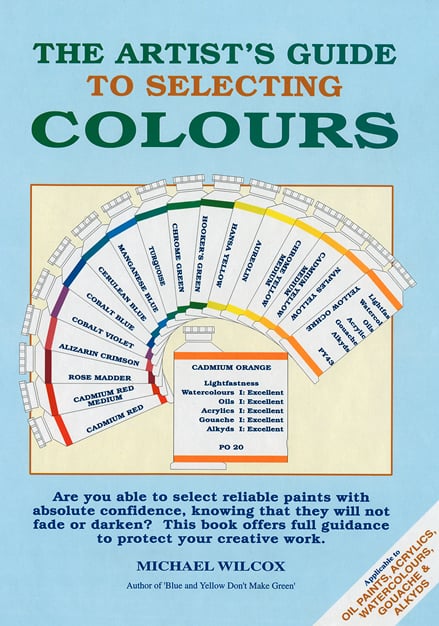

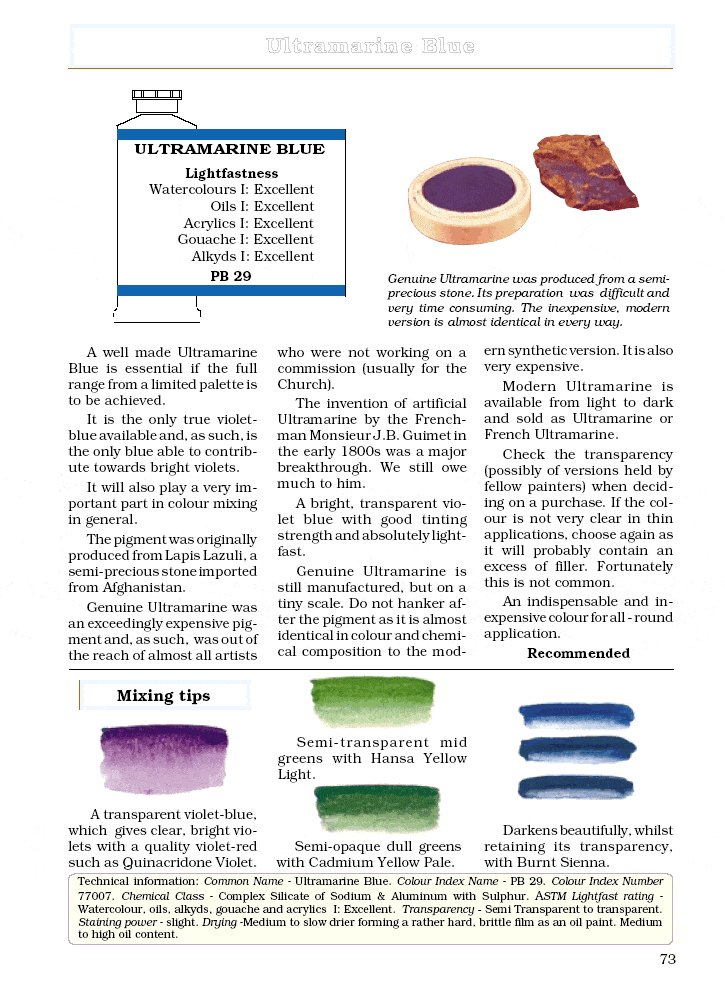

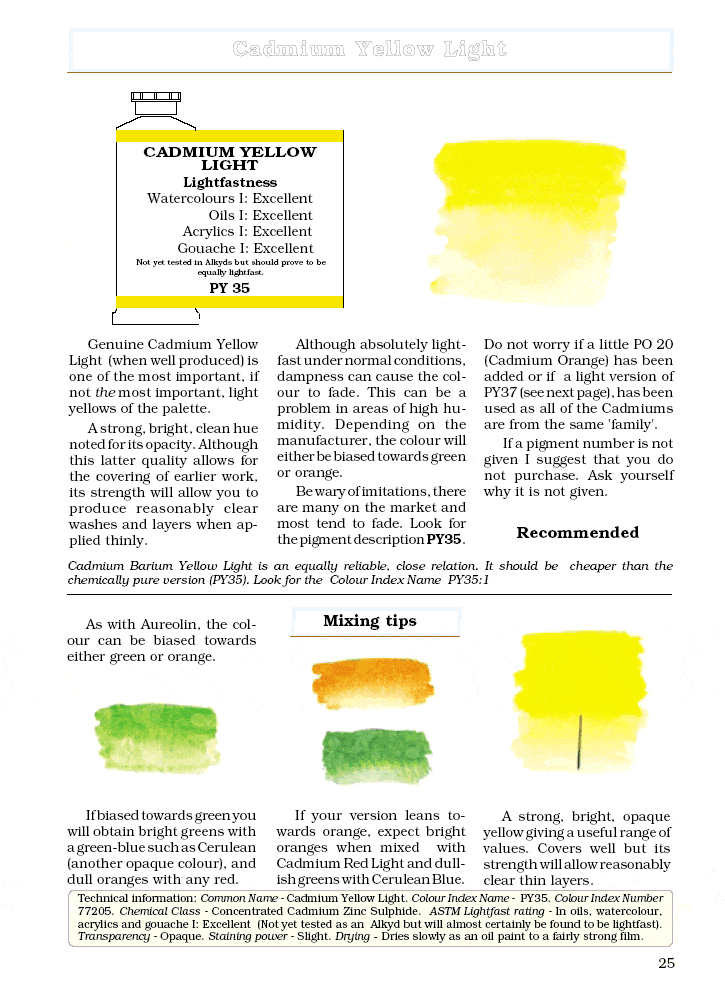
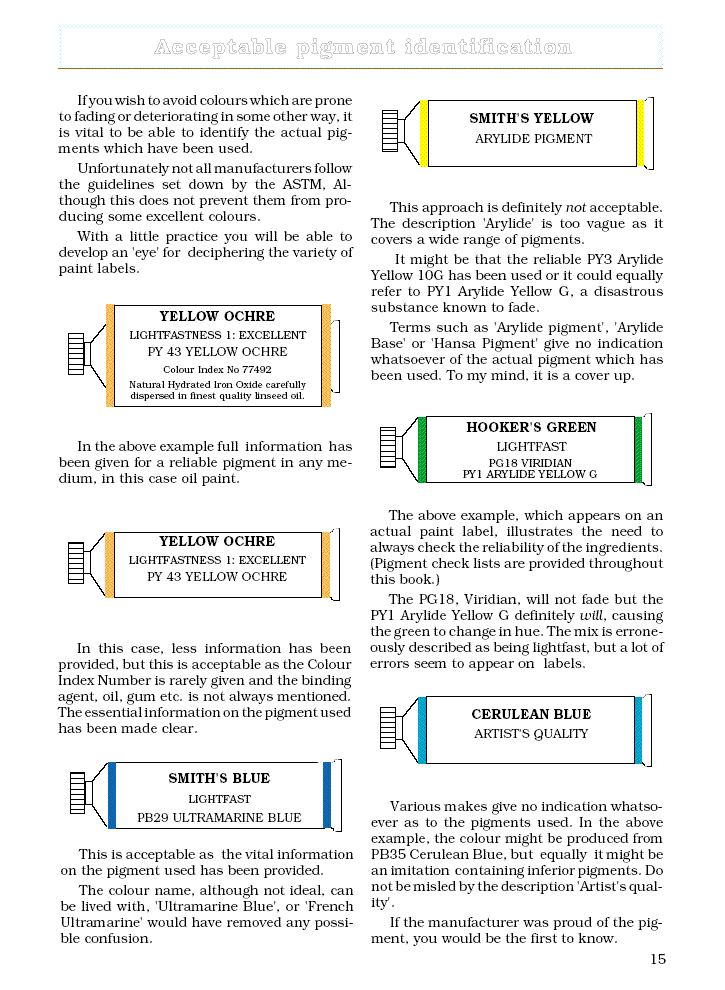
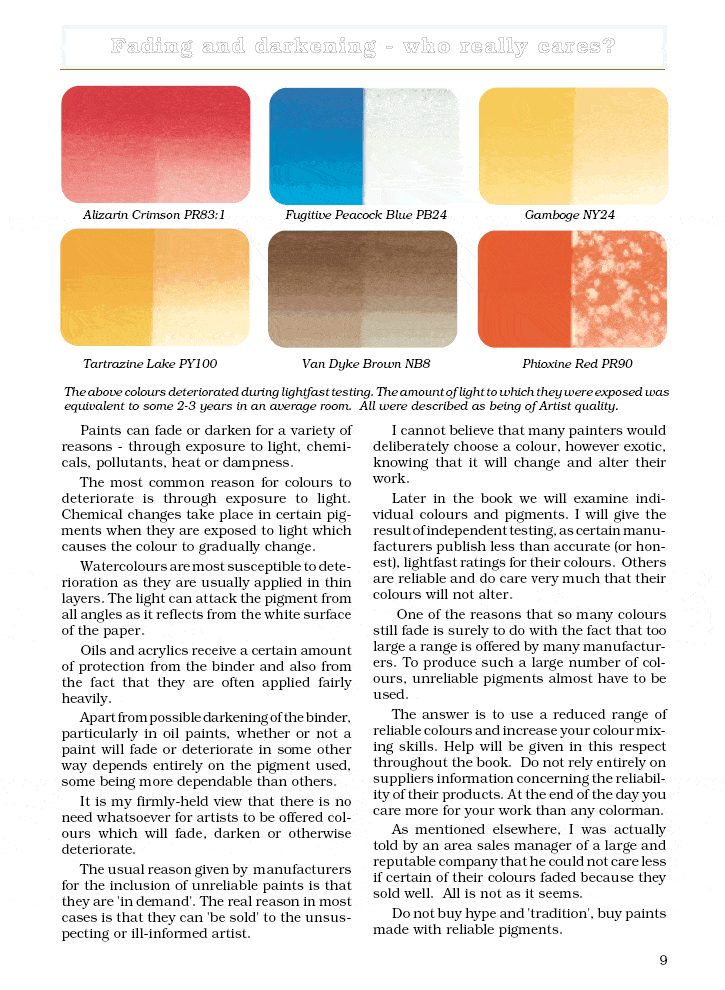
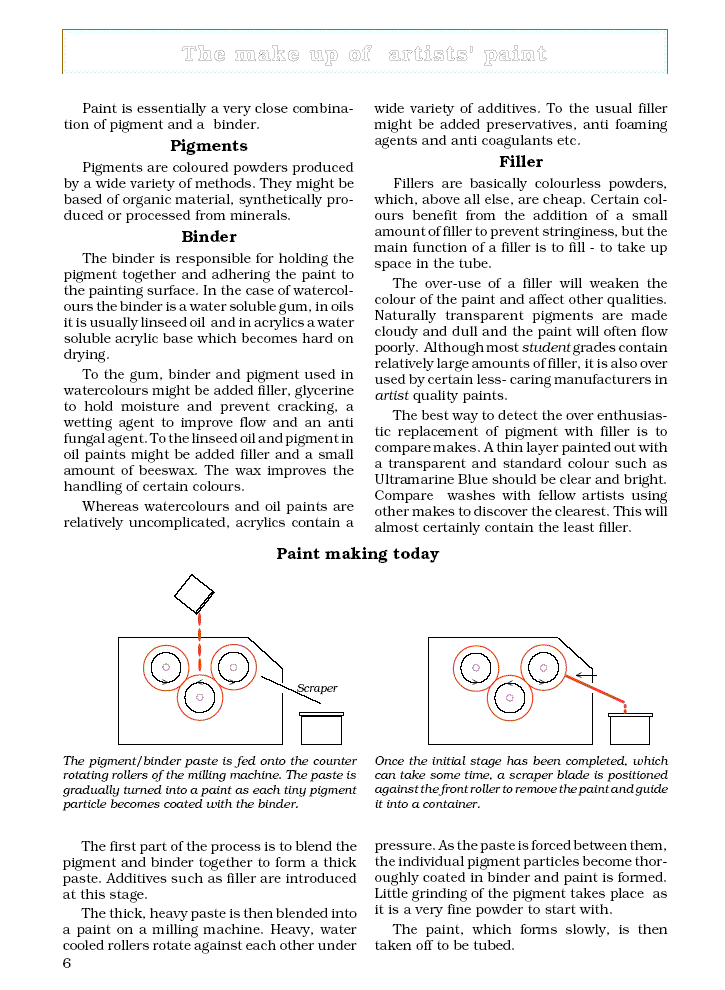

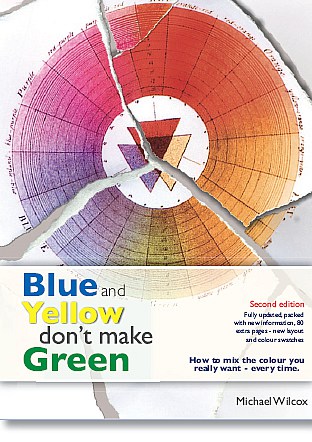

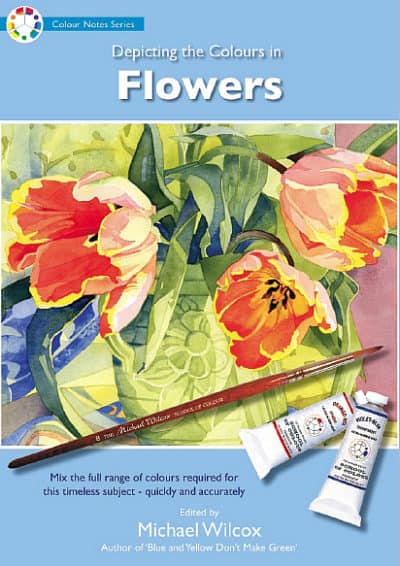
amazon –
Five Stars
Awesome description and guidance for colors. Great book.
By Mary Goforth (AMAZON – Verified Purchase)
amazon –
Essential reading for ALL visual artists. Money saver! Frustration prevention. READ IT!
If you are an artist, you already know Michael Wilcox and his works.
This differs from “Yellow and Blue DON’T make GREEN!” in that its focus is on finding the best and fewest QUALITY pigments for any medium. He did a LOT of research so you don’t have to waste money on too many “convenience” colors or by buying poor paint.
He cover many brands, all the essential colors and numerous non-essential but favorite colors. He names names and pulls no punches. Find out who has been LYING to you and selling bad paint that makes you hate painting and want to give up.
This book SAVES artists money because he finds the good stuff and teaches you how to recognize it by proper labeling. He also tells you to avoid any product without proper labeling and how to tell when manufacturers obfuscate or outright LIE about their products.
If you are new to painting, understanding the information herein will save you HUNDREDS of dollars, maybe more. No, I am NOT exaggerating.
Given the skyrocketing cost of high-quality pigments, It makes sense to buy only the best and only what you need. The dual-primary palette, the “process” primary palette, or even the extended twelve-color palette will accommodate any conceivable color mixture. To truly understand how to use those colors, you should also read his first book, but you will benefit even if you only get this one.
No matter what your style or medium, this is an essential reference for all visual artists. Get it, Read it. Commit it to memory. You will be glad you did on your next paint order, and then for the rest of your life. Your painting will improve and your wallet will thank you.
By G. Conner (AMAZON – Verified Purchase)
amazon –
I love this book and refer to it often as I …
I love this book and refer to it often as I decide what paints I want to buy. This is a must for any professional artist or person who’s making work that they want to last the test of time. Some newer lab made pigments are absent from this book, but you’ll still find 90% of the ones made referenced here. There’s also a good bit of information on the history of various pigments, which can be quite interesting too.
By L Dickson (AMAZON – Verified Purchase)
amazon –
Useful
The following refers to a copy published by the “School of Colour Publishing” not the North Light one here. Hence I have no idea as to how NL may have messed around with it (I’m not a big fan of North Light – found their books, for the most part, to be woefully focused on the “twee” end of the picture creating spectrum).
The Australian (hence the presumed typo’s) Michael Wilcox does an admirable job of outlining which pigments to use (and avoid), in what media i.e oil, acrylic, watercolour and gouache, and why. Much of the information can be found elsewhere (Mayer’s “The Artist’s Handbook”) but I favour Wilcox owing to the book being in colour, with an excellent reproduction of the hues compared with actual colour swatches I’ve made.
Given that the various paint manufacturer’s are continually on the look out for “new” colours I found a couple of pigments in my oil paints that weren’t mentioned in the book.
With reference to another review posted here, I didn’t find any instance of Wilcox promoting his range of materials.
A very useful book, particularly for someone using paints from a variety of manufacturer’s as well someone working in a range of media.
By Brian Asquith (AMAZON – Verified Purchase)
amazon –
starsNew Art Approach
I was hesitant in purchasing this book for fear it would be too much of a challenge to read it much less try to follow it. That has
not been the case…however, I suggest one does take the time to follow it by doing as one learns the process. It will take
time but your art will take on a new dimension.
By M. Webb (AMAZON – Verified Purchase)
amazon –
great asset to new painters!
Great book! It was recommended by an accomplished artist/ teacher I met online. I’m a self-taught artist. This book is great!
By F. Wilson (AMAZON – Verified Purchase)
amazon –
Definately recommended
Michael Wilcox, both an artist and a chemist, is on a holy mission to save the world from bad paint and is the perfect person to disabuse the public of the myths that keep it at the mercy of unscrupulous paint manufacturers.
Artists need to know that many popular colors (such as traditionally-made alizirin crimson) are appallingly fragile in ANY medium and will always deteriorate in short periods of time. And yet there are wonderfully lightfast substitutes available, if only the artist knows what to look for.
This informative, nicely illustrated book is a must for any painter who cares about the durability of his or her work. Furthermore, it can never go out of date because it offers information on the properties of PIGMENTS, and not reviews of paint products. If you know which pigments are stable, it won’t matter which brands you come across at your local art supply store. Just read the ingredients to find out whether a paint will stand the test of time.
By Sorrel Wood (AMAZON – Verified Purchase)
amazon –
Great resource yet needs updating
I was fortunate enough to run across a copy of Michael Wilcox’s book years ago, when art supply manufacturers were in the process of eliminating fugitive pigments and replacing them with more permanent ones. Often a color is a blend of two or more pigments, so things get complicated, yet Michael Wilcox doesn’t go into that rat’s nest, but sticks to permanency data on the single pigments that we find in artisits’ colors.
Unfortunately, by now the book is somewhat outdated. That is, as one other reviewer has indicated, there are newer pigments out that just aren’t listed in the book. As an artist who would like his paintings to last, at least a reasonable length of time, careful color selection is important. I would like to see Michael Wilcox turn out a new edition of this volume.
By J. Pawling (AMAZON – Verified Purchase)
amazon –
Amazing!
This book is a must have for any serious artist. It’s one thing to use lesser paints for studies or just starting out but it’s quite another when you are selling your art work. No collector wants their art investment to not stand the test of time.
By Melissa Shipley (AMAZON – Verified Purchase)
amazon –
An Excellent Resource
This is an essential book for any serious artist concerned about the integrity of their art. Who cares if there are typos? (I noticed none, myself -refer to a previous review). If you are knocking a book like this for whatever spelling/grammatical errors the subject matter is over your head. The author thoroughly explains everything to look for when selecting the best color pallet. Watch out for misleading labels, redundant and unnecessary products, fugitive colors and hidden ingredients that threaten the longevity of your work.
By M (AMAZON – Verified Purchase)
amazon –
Excellent reference with no ulterior motives..
I have the book in front of me and there are no references here to any particular brand of paint. This is an excellent reference work, if for no other reason than to stir one’s motivation to mix more colors with fewr pigments and to know what one is using… The advise is sound, timeless and helpful.
By Astrotom (AMAZON – Verified Purchase)
amazon –
Excellent and Vital Reference Book
Important information for choosing the best colors in your palette. I now am confident in the archival integrity of the palette I use and I arrange the colors according to those that form the purest color mixtures. An earlier review speaks of typos -1. Apparently this person is ignorant of the Queen’s English (Michael Wilcox is British) -2. Who cares to throw out the baby with the bath water anyway? This is the clearest reference I have found on pigments.
By Art (AMAZON – Verified Purchase)
amazon –
The Most Helpful Book In My Art Library
I would never again purchase a tube of paint that did not conform to the ASTM Standards that Michael Wilcox describes in easy to understand terms. I have owned this book for several years and still refer to it often. If a pigment has been proven through research to crack or change colors with time, better color mixtures using proven pigments are given in each instance. A most valuable tool for any artist’s library.
By Ann Garlough (AMAZON – Verified Purchase)
amazon –
A worthwhile reference book
This is the latest in a fine series of reference books on color and paint selection written by Mr. Wilcox. This book delivers lots of useful information in clear language. I would particularly recommend it to students who are new to the sometimes bewildering world of color media. Readers who have the author’s other books on color may not need this one, as there is a lot of overlap.
By A customer (AMAZON – Verified Purchase)
amazon –
An informative book for students, teachers and artists!
A very informative book for any artist. We all buy paint, but the market is full of many brands and many qualities of paint. How do we make a selection? How do we avoid colors that fade or darken? How do we read the label of the tube of paint? What should be on that label? The name of the color is not important.All painters know that there are many different colors with the same name.
By Penny Ross (AMAZON – Verified Purchase)
amazon –
Five Stars
Very pleased. Recommended by many professional artist, and it disappoint.
By m l harmon (AMAZON – Verified Purchase)